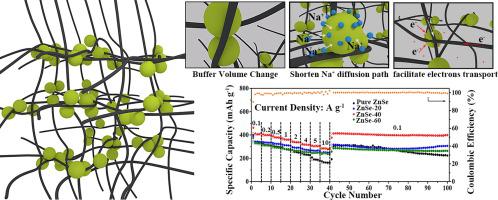当前位置:
X-MOL 学术
›
Appl. Surf. Sci.
›
论文详情
Our official English website, www.x-mol.net, welcomes your
feedback! (Note: you will need to create a separate account there.)
ZnSe nanoparticles combined with uniform 3D interconnected MWCNTs conductive network as high-rate and freeze-resistant anode materials for sodium-ion batteries
Applied Surface Science ( IF 6.3 ) Pub Date : 2021-02-01 , DOI: 10.1016/j.apsusc.2020.148194 Yunmei Zhou , Xiaohong Sun , Anran Fan , Yunpeng Shang , Kunzhou Xiong , Jinze Guo , Shibo Jin , Shu Cai , Chunming Zheng
Applied Surface Science ( IF 6.3 ) Pub Date : 2021-02-01 , DOI: 10.1016/j.apsusc.2020.148194 Yunmei Zhou , Xiaohong Sun , Anran Fan , Yunpeng Shang , Kunzhou Xiong , Jinze Guo , Shibo Jin , Shu Cai , Chunming Zheng

|
Abstract ZnSe as anode material for sodium ion batteries (SIBs) has received great attention due to its high theoretical specific capacity, environmental friendliness and low price. However, its electrochemical performance is hindered by large volume variation and poor electrical conductivity. In this work, we reported a one-step hydrothermal strategy of ZnSe/MWCNTs (Multi-walled Carbon Nanotubes) to form ZnSe nanoparticles combined with uniform 3D interconnected MWCNTs conductive network to synergistically boost sodium-ion storage process. Especially, the uniform 3D interconnected MWCNTs conductive network plays a vital role of enhanced electracial conductivity, ionic diffusivity and structural stability so that it can achieve excellent electrochemical performance at both room and low temperature. Also, pseudocapacitance in redox processes is dominated leading to superior rate performance. When the optimal ZnSe/MWCNTs (denoted by ZnSe-40) are applied at room temperature, it delivers 398.8 mA h g-1 at 0.1 A g-1 after 50 cycles and superior rate performance (279.4 mA h g-1 at 10 A g-1). Its capacity retention can still be 93% at 4 A g-1 after 300 cycles. What is pleasantly surprised, even at low temperature (-10 °C), ZnSe-40 shows good long-term cycling stability of 246.7 mA h g-1 at 1 A g-1 after 600 cycles and 180.5 mA h g-1 at 5 A g-1. The reaction mechanism in sodiation/desodiation process is explored by discussing the change of intermediate products through ex-situ characterization methods.
中文翻译:

ZnSe纳米颗粒结合均匀的3D互连MWCNTs导电网络作为钠离子电池的高倍率和抗冻负极材料
摘要 ZnSe作为钠离子电池(SIBs)负极材料因其理论比容量高、环境友好和价格低廉而备受关注。然而,其电化学性能受到体积变化大和导电性差的阻碍。在这项工作中,我们报道了 ZnSe/MWCNTs(多壁碳纳米管)的一步水热策略,以形成 ZnSe 纳米颗粒,结合均匀的 3D 互连 MWCNTs 导电网络,协同促进钠离子存储过程。特别是,均匀的 3D 互连 MWCNTs 导电网络在增强电导率、离子扩散率和结构稳定性方面起着至关重要的作用,使其在室温和低温下都能实现优异的电化学性能。还,氧化还原过程中的赝电容占主导地位,导致优异的倍率性能。当最佳 ZnSe/MWCNTs(由 ZnSe-40 表示)在室温下应用时,它在 0.1 A g-1 下在 50 次循环后提供 398.8 mA h g-1 和优异的倍率性能(279.4 mA h g-1 在 10 A g-1)。300 次循环后,其容量保持率在 4 A g-1 下仍可保持 93%。令人惊喜的是,即使在低温 (-10 °C) 下,ZnSe-40 也表现出良好的长期循环稳定性,在 1 A g-1 下 600 次循环后为 246.7 mA h g-1,在 180.5 mA h g-1 下5 A g-1。通过非原位表征方法讨论中间产物的变化,探讨了钠化/脱钠过程中的反应机理。50 次循环后 0.1 A g-1 下为 8 mAh g-1,倍率性能优异(10 A g-1 下为 279.4 mAh g-1)。300 次循环后,其容量保持率在 4 A g-1 下仍可保持 93%。令人惊喜的是,即使在低温 (-10 °C) 下,ZnSe-40 也表现出良好的长期循环稳定性,在 1 A g-1 下 600 次循环后为 246.7 mA h g-1,在 180.5 mA h g-1 下5 A g-1。通过非原位表征方法讨论中间产物的变化,探讨了钠化/脱钠过程中的反应机理。50 次循环后 0.1 A g-1 下为 8 mAh g-1,倍率性能优异(10 A g-1 下为 279.4 mAh g-1)。300 次循环后,其容量保持率在 4 A g-1 下仍可保持 93%。令人惊喜的是,即使在低温 (-10 °C) 下,ZnSe-40 也表现出良好的长期循环稳定性,在 1 A g-1 下 600 次循环后为 246.7 mA h g-1,在 180.5 mA h g-1 下5 A g-1。通过非原位表征方法讨论中间产物的变化,探讨了钠化/脱钠过程中的反应机理。
更新日期:2021-02-01
中文翻译:

ZnSe纳米颗粒结合均匀的3D互连MWCNTs导电网络作为钠离子电池的高倍率和抗冻负极材料
摘要 ZnSe作为钠离子电池(SIBs)负极材料因其理论比容量高、环境友好和价格低廉而备受关注。然而,其电化学性能受到体积变化大和导电性差的阻碍。在这项工作中,我们报道了 ZnSe/MWCNTs(多壁碳纳米管)的一步水热策略,以形成 ZnSe 纳米颗粒,结合均匀的 3D 互连 MWCNTs 导电网络,协同促进钠离子存储过程。特别是,均匀的 3D 互连 MWCNTs 导电网络在增强电导率、离子扩散率和结构稳定性方面起着至关重要的作用,使其在室温和低温下都能实现优异的电化学性能。还,氧化还原过程中的赝电容占主导地位,导致优异的倍率性能。当最佳 ZnSe/MWCNTs(由 ZnSe-40 表示)在室温下应用时,它在 0.1 A g-1 下在 50 次循环后提供 398.8 mA h g-1 和优异的倍率性能(279.4 mA h g-1 在 10 A g-1)。300 次循环后,其容量保持率在 4 A g-1 下仍可保持 93%。令人惊喜的是,即使在低温 (-10 °C) 下,ZnSe-40 也表现出良好的长期循环稳定性,在 1 A g-1 下 600 次循环后为 246.7 mA h g-1,在 180.5 mA h g-1 下5 A g-1。通过非原位表征方法讨论中间产物的变化,探讨了钠化/脱钠过程中的反应机理。50 次循环后 0.1 A g-1 下为 8 mAh g-1,倍率性能优异(10 A g-1 下为 279.4 mAh g-1)。300 次循环后,其容量保持率在 4 A g-1 下仍可保持 93%。令人惊喜的是,即使在低温 (-10 °C) 下,ZnSe-40 也表现出良好的长期循环稳定性,在 1 A g-1 下 600 次循环后为 246.7 mA h g-1,在 180.5 mA h g-1 下5 A g-1。通过非原位表征方法讨论中间产物的变化,探讨了钠化/脱钠过程中的反应机理。50 次循环后 0.1 A g-1 下为 8 mAh g-1,倍率性能优异(10 A g-1 下为 279.4 mAh g-1)。300 次循环后,其容量保持率在 4 A g-1 下仍可保持 93%。令人惊喜的是,即使在低温 (-10 °C) 下,ZnSe-40 也表现出良好的长期循环稳定性,在 1 A g-1 下 600 次循环后为 246.7 mA h g-1,在 180.5 mA h g-1 下5 A g-1。通过非原位表征方法讨论中间产物的变化,探讨了钠化/脱钠过程中的反应机理。











































 京公网安备 11010802027423号
京公网安备 11010802027423号